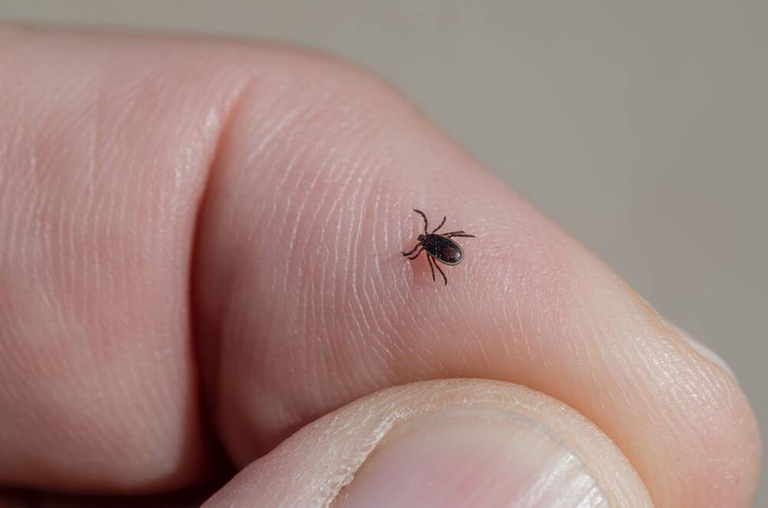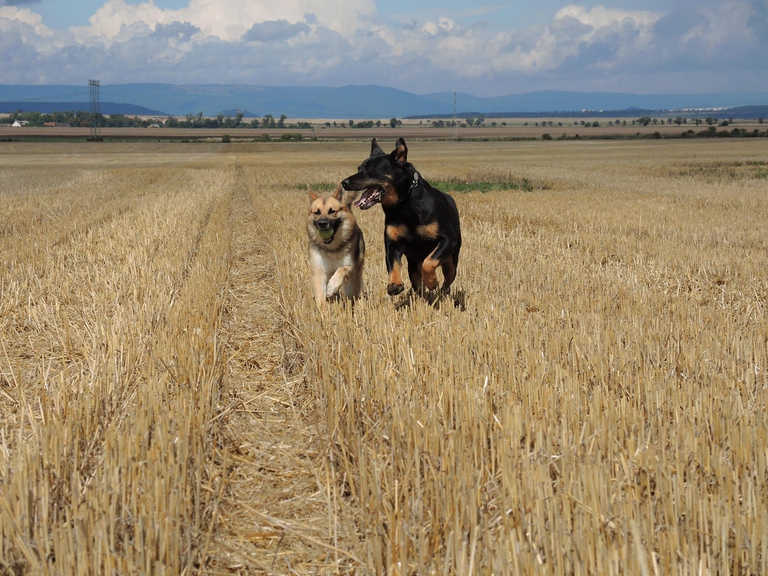https://www.lifegate.it/invasione-delle-zecche-caldo-e-siccita
- |
The ticks I never liked them.Perhaps for their shape – the little legs that cling to the skin and the beak that voraciously sucks blood – or for the reputation they bring with them.That of parasites dangerous for us and for our four-legged friends, capable of propagating and transmitting dangerous pathologies and, sometimes, deadly.This year, then, the presence of ticks has become particularly insidious and has pushed me to ask the experts for guidance to understand the reason.A why that has to do with i climate changes to which we are subjected and which turns into another of the dangers that an out-of-control climate reserves for men and animals.But let's go in order.

Ticks are not only dangerous to animals
Ticks are arthropods belonging to the class of arachnids, the same as spiders, mites and scorpions, and are equipped with eight legs to the adult stage (unlike insects which have six).They are divided into ticks hard, characterized by the presence of a leathery dorsal shield, e soft ticks without shield.The latter are more widespread in birds, but they also feed on the blood of humans and other animals, abandoning the host once the meal is finished and causing often severe local reactions.Hard ticks are bloodsucking parasites considered long feeders, because they live on the parasitized subject for a long time (from two to seven days), usually abandoning it only for the moulting phases and for the laying of eggs which takes place on the ground.
In Italy they have been identified approximately 36 species of ticks and all have a peak of spring and autumn activity, but many of them are able to carry out their activity also in the winter period, therefore 12 months a year even in northern latitudes.

What are tick-borne diseases?
Hard ticks prefer grassy or wooded environments, frequented by domestic or wild animals, but some species (such as the so-called dog tick) have also adapted to hot and dry environments and therefore can easily be found in courtyards with cracks and crevices, in city areas.These parasites are carriers of numerous pathogens and can cause allergenic or even paralyzing problems.In theirs saliva, in fact, they are present neurotoxins capable of causing progressive paralysis in animals and humans which can lead to death due to respiratory or cardiac failure.The doctor Chiara Dissegna, veterinary doctor, gives me a list of illnesses transmitted by ticks in our territory.
- There babesiosis or piroplasmosis:disease sustained by haemoprotozoa of the genus Babesia which infect erythrocytes and are transmitted by hard ticks.Babesias are generally highly specific to both the tick that acts as a vector and the host mammal.It affects dogs while cases of infection in cats are relatively rare.It can also affect humans.
- THE'erlichiosis it is a febrile illness caused by obligate intracellular bacteria.The dog is the main host of AND.canis, the vector is the mint Rhipicephalus sanguineus.There are no relevant clinical reports in cats.
- THE'anaplasmosis, a disease caused by obligate intracellular bacteria of the anaplasma genus, reported in dogs and rarely in cats.There have been some reports in humans.
- There borreliosis or Lyme disease it is caused by borrelia.The complex Borrelia burgdorferi includes eleven species/genotypes of Spirochetes which infect many mammals (including dogs, cats and humans) and birds and are transmitted by ticks of the species Ixodes ricinus, I.hexagonus and I.persulcatus.
- There tbe (tick-borne encephalitis or tick-borne encephalitis) is transmitted by tick bite to various vertebrates, including humans and dogs.The cat, however, is not susceptible to this disease.
- There rickettsiosis it is an infection caused by bacteria of the rickettsia genus and can occur in dogs, cats and humans, causing Mediterranean button fever in our area.
- Ticks can also transmit it to humans tularemia (also called rabbit fever, another fearful zoonosis), although this route of transmission is less frequent.
The risks for dogs and cats
As we have seen from the list of transmitted diseases, ticks can also be unwanted guests cats.On the problems generated by these parasites, the veterinary analysis laboratory Mylav also addressed the topic of felines, with the support of Luigi Venco, veterinary doctor small animal clinic specialist.
Generally, ticks are not very selective in choosing their host, but they can choose dogs, cats, humans and other species of large and small wild animals (from ungulates to hedgehogs).Unfortunately for those who live with a dog it is good to know that the species is infested with ticks very frequently.A recent investigation has shown how specimens that go to the vet have at least one tick not noticed by the owner in over 40 percent of cases.For this reason, the pharmacological prevention recommended by the veterinary doctor is essential.“However, after each walk, it is a good idea to observe the dog's skin and coat, particularly in the interdigital spaces and at the neck, head and ears which are the most frequently affected areas”, adds Dr. Venco.

Heat and drought favor the presence of ticks
Why are we seeing an increase in these parasites both in the city and in areas outside metropolitan areas this year?"The climate it is the most important variable in determining the development of ticks.The activity of these parasites is linked, in fact, to the values of temperature And humidity.During the winter, to protect themselves from the cold, they take refuge in walls, under stones or vegetation, burying themselves deep.With the beginning of spring they emerge from this form of hibernation and begin to get busy.THE climate changes and higher than normal temperatures allow a prolongation of the tick activity period.The wild animals they then influence the movement and their diffusion (not only the ungulates who are spotted in city areas now every day, but also the birds can move these vectors),” he explains Chiara Draws.
These little parasites have extremely ingenious aggression techniques.Once on the host, the tick begins its blood meal which occurs in two phases.The first, called “slow”, lasts approximately 24 hours and is necessary for the tick to accommodate the digestive system.Then the rapid sucking phase begins, during which the tick takes in significant quantities of blood and to do this regurgitates the liquid component of the ingested blood, retaining only the nutrients.In this phase the transmission of pathogens present in the mint itself.Some mints, which Riphicephalus sanguineus (the most common one in dogs), often organize themselves into small groups that bite the host in the same position.In this way the action of anticoagulant enzymes injected by each tick is enhanced by encouraging the meal and shortening the slow phase (the non-risky one) to eight instead of 24 hours.
With the premature heat of this early summer, ticks have made their early appearance especially in regions of northern Italy like the Piedmont and the Veneto.The newspaper The arena reported the alarm some time ago, explaining that the ticks are lurking a couple of months in advance.The blame has been placed on several factors, from excessive heat to the presence of wild animals such as wild boars which, although not directly affected by the zoonoses transmitted by ticks, are necessarily amplifiers for these particular insects.In Piedmont, however, regarding their invasion, there was talk of a long dry season accompanied by high temperatures already at the end of a too short spring.And it doesn't end here.In Emilia-Romagna, even as I am writing this editorial, an increase in the babesiosis (also called piroplasmosis).In short, there are many reasons as usual, but in the foreground there is always the climate emergency and the damage that out-of-control temperatures are causing to the ecosystem.

Be careful to eliminate them well
Once the tick - or ticks - have been identified on the body of our four-legged friend or on our skin, the important thing is to eliminate the parasite in the best way, ensuring that no trace of its body remains in the area of skin where it is attached .“Both in our animals and in humans, to remove a tick it is necessary to grasp it with one tweezers at thin points, as close as possible to the surface of the skin, at the level of the rostrum, and remove it by exercising delicate and progressive traction”, warns Dr. Venco.
“There are some on the market specific extractors which facilitate the maneuver.During removal, maximum care must be taken not to crush the body of the tick, to avoid regurgitation which increases the possibility of transmitting any pathogens.It is then recommended to store the parasite in a bottle with alcohol al 70 percent for possible isolation of pathogens in the event of subsequent appearance of symptoms.It is absolutely contraindicated, before removing the tick, to sprinkle it with alcohol, gas, trichlorethylene, ammonia, oil, greases or insecticides, or scald it with red-hot objects such as cigarettes to prevent the induced suffering from causing the regurgitation of infected material and the transmission of pathogens.If the infestation is massive or caused by numerous ticks, it is best to contact your veterinarian who will suggest pharmacological treatment with drugs that have rapid action."

How to defend our four-legged friends
For some time now veterinary pharmaceutical companies they are proposing pesticide products against fleas and ticks ranging from spray to spot-on, up to collars and which can avoid contagion for a few months.“The application of external pesticides in dogs and cats to combat ticks is absolutely essential, especially if we live in the countryside or go on holiday in the mountains.Especially in the field of large animals, However, ticks are increasingly resistant to the products used so far.Veterinary research, therefore, is committed to finding new active molecules and is also working in the research of natural products effective.Studies on the effectiveness of essential oils are particularly promising and open up a world of possibilities in harmony with nature for effective prevention", concludes Dr. Dissegna.
And it is precisely on this front that those who care about the health of the environment hope that a concrete solution can be found soon.For the moment, in fact, the many - too many - discussions about the climate and the consequences of rising temperatures seem to be running out of time.And the worst prospects become, day by day, more concrete and immediate.The hope is that man will finally realize the damage caused to the environment and actively remedy it.
